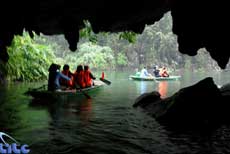Tenfold increases in local incomes, reduced poverty, increased cultural and foreign language understanding, investment in infrastructure and increased skills and social understanding make Trang An Ecological Tourist Site, Vietnam's "Ha Long Bay on Land", a true example of best practice community-based tourism.
 Trang An, in Vietnam's North-Eastern Red River Delta Region, is an unique natural and cultural landscape that is well on the way to becoming a UNESCO cultural heritage landscape ("Trang An Scenic Landscape Complex" is one of seven sites in Vietnam that are currently listed under UNESCO's Tentative Lists for consideration as World Heritage Sites). The site, which has been called an "outdoor geological museum" not only boasts 500 plant species, 73 bird species, 41 animal species and 31 reptile species; it but also encourages the preservation of traditional crafts such as embroidery, pottery and stone carving.
Trang An, in Vietnam's North-Eastern Red River Delta Region, is an unique natural and cultural landscape that is well on the way to becoming a UNESCO cultural heritage landscape ("Trang An Scenic Landscape Complex" is one of seven sites in Vietnam that are currently listed under UNESCO's Tentative Lists for consideration as World Heritage Sites). The site, which has been called an "outdoor geological museum" not only boasts 500 plant species, 73 bird species, 41 animal species and 31 reptile species; it but also encourages the preservation of traditional crafts such as embroidery, pottery and stone carving.
Trang An, whose development has been planned by the Ninh Binh Provincial Department of Culture, Sports and Tourism in conjunction with Xuan Truong Construction Company, provides alternatives to traditional agriculture-based work for local residents: The tourist site, which covers a surface area of almost 5,000 hectares, is most famous for its 1,000 row boats, which are owned by Xuan Truong Construction Company but managed by locals.
Traditionally, local residents are farmers. However, with the arrival of tourists to Trang An, many people became involved in boating as a way to earn a higher income for their families (an average farmer in the region earns 300,000 VND (€12) per month; a boat manager earns up to 3,000,000 VND (€117) - a tenfold increase in monthly income).
Along with increased salaries, the tourism boating industry in Trang An has created increased employment opportunities for local people, contributed to the elimination of poverty, helped to boost skills and fostered social and cultural understanding as well as foreign language understanding. Local residents have been educated on environmental protection, the importance and benefits of maintaining their cultural heritage and techniques to encourage tourists to help ensure the cleanliness of Trang An's fragile environment.
And the tourists are arriving in droves - thousands come from Viet Nam and abroad every day to experience what is now known as "Ha Long Bay on land" - an impressive association given the latter´s global fame and UNESCO World Heritage status.
However, such popularity comes with responsibility - a responsibility to protect the natural and cultural heritage of the site and ensure that any future developments are sustainable. At present, there are no limitations to the amount of tourists allowed to visit Trang An at any one time. Ninh Binh Provincial People´s Committee and Xuan Truong Construction Company already have plans to expand the site from 5,000 hectares to 12,000 hectares, with new facilities to include a reception, visitor, interpretation and MICE center, a cave/grotto tourist site, a spiritual area (Bai Dinh Pagoda) and cultural park area. New routes and tours are also in development.
Trang An is an unique and impressive tourism attraction of Viet Nam, and one which has already proven its ability to bring a multitude of benefits to the local community. To ensure that these benefits continue into the future, the responsible and participative management of the site is essential.